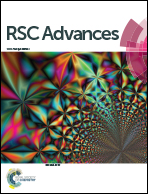A redox-active support for the synthesis of Au@SnO2 core–shell nanostructure and SnO2 quantum dots with efficient photoactivities†
Abstract
A defect pyrochlore-type Sn1.06Nb2O5.59F0.97 (SnNbOF) nano-octahedron is used as a redox-active support for fabricating Au@SnO2 core–shell and SnO2 quantum dots at room temperature without the use of organic species or foreign reducing reagents. Gold (Au) and SnO2 components were obtained through an in situ redox reaction between the HAuCl4 and reductive Sn2+ ions incorporated in SnNbOF. The composition and morphology of the resulting nanocomposites (denoted as Au–SnNbOF) could be controlled by adjusting the Au/SnNbOF ratio. The Au–SnNbOF nanocomposites exhibited efficient photoactivities for methyl orange (MO) degradation under the visible light irradiation (λ > 420 nm), during which the MO was almost completely degraded within 8 min. Among all the samples, the 5wt% Au–SnNbOF nanocomposite had the highest rate constant (0.43 min−1), which was 40 times higher than that of the blank SnNbOF.



 Please wait while we load your content...
Please wait while we load your content...